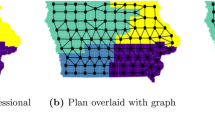Abstract
Since 2011, the U.S. Supreme Court has issued 15 redistricting opinions. But a recent Supreme Court ruling puts the question of partisan gerrymandering firmly in the hands of states. The U.S. Supreme Court ruled in Rucho v. Common Cause that the federal courts have no jurisdiction over issues of partisan gerrymandering. The court did, however, point to state remedies.
Gerrymandering is the practice of drawing lines of voting districts to favor or harm any person or group. This practice denies opportunity for full political participation and representation to the harmed party. Since 2004, when the U.S. Supreme Court case of Vieth v. Jubelierer was decided, opponents of gerrymandering have been searching for “workable standards” to measure and prove gerrymandering.
In any case, a number of common redistricting principles have evolved. Map drawers should use results of these criteria to inform decision makers and the public. Rules against gerrymandering are not codified, but some other traditional practices of redistricting are. Thus, this paper will outline varying measures for compactness, and rules against splitting political units. This paper will further discuss proposed standards concerning gerrymandering, using new mathematical methods and principles, such as the efficiency gap, and sampling (using the Markov chain Monte Carlo method).
Access this chapter
Tax calculation will be finalised at checkout
Purchases are for personal use only
Similar content being viewed by others
References
Barabas, J., & Jerit, J. (Winter 2004). Redistricting principles and racial representation. State Politics & Policy Quarterly, 4(4), 415–435. https://doi.org/10.1177/153244000400400404.
Bernstein, M., & Duchin, M. (2017). A formula goes to court: Partisan gerrymandering and the efficiency gap. Notices of the American Mathematical Society, 64(09), 1020–1024. https://doi.org/10.1090/noti1573.
Bowen, D. C. (2014). Boundaries, redistricting criteria, and representation in the U.S. house of representatives. American Politics Research, 42(5), 856–895. https://doi.org/10.1177/1532673x13519127.
Charles, G. E., Gupta, D., & Wilf-Townsend, D. (2019, March 8). Amicus brief of mathematicians, law professors and students in support of appellees and affirmance. Retrieved from https://mggg.org/SCOTUS-MathBrief.pdf
Common Cause. (n.d.). Partisan gerrymandering writing competition. Retrieved from https://www.commoncause.org/partisan-gerrymandering-writing-competition/
Common Cause v. Rucho, 279 F. Supp. 3d 587, M.D.N.C. (2018). Retrieved from https://casetext.com/case/cause-v-rucho-4
Common Cause v. Rucho, 318 F.Supp.3d 777, 799+, M.D.N.C. (2018). Retrieved from https://casetext.com/case/cause-v-rucho-5?
Curiel, J. A., & Steelman, T. (December 2018). Redistricting out representation: Democratic harms in splitting zip codes. Election Law Journal: Rules, Politics, and Policy, 17(4), 328–353. https://doi.org/10.1089/elj.2018.0528.
Denton, J. (2018, June 28). Breaking down the Supreme Court’s inaction on gerrymandering. Pacific Standard. Retrieved from https://psmag.com/news/breaking-down-the-supreme-courts-inaction-on-gerrymandering
Duchin, M. (2018a). Geometry versus gerrymandering. Scientific American. Retrieved from https://www.scientificamerican.com/article/geometry-versus-gerrymandering/
Duchin, M. (2018b). Gerrymandering metrics: How to measure? What’s the Baseline? Arxiv. Retrieved from https://arxiv.org/pdf/1801.02064.pdf
Every Vote Counts. (n.d.). Partisan Gerrymandering. Retrieved from https://www.evcnational.org/partisan-gerrymandering
Forgette, R., Garner, A., & Winkle, J. (2009, Summer). Do redistricting principles and practices affect U.S. state legislative electoral competition? State Politics & Policy Quarterly, 9(2), 151–175. https://doi.org/10.1177/153244000900900202.
Gabriel, T. (2018, January 26). In a comically drawn Pennsylvania District, the voters are not amused. The New York Times. Retrieved from https://www.nytimes.com/2018/01/26/us/pennsylvania-gerrymander-goofy-district.html
Glossary. (n.d.). Retrieved from https://redistricting.azavea.com/glossary/
Grofman, B., & King, G. (2007). The future of Partisan symmetry as a judicial test for Partisan gerrymandering after LULAC v. Perry. Election Law Journal: Rules, Politics, and Policy, 6(1), 2–35. https://doi.org/10.1089/elj.2006.6002.
Iowa Code § 42.4. Retrieved from https://www.legis.iowa.gov/docs/code/2016/42.4.pdf
Levitt, J. (2010). A citizen’s guide to redistricting. Retrieved from https://www.brennancenter.org/sites/default/files/legacy/Democracy/CitizensGuidetoRedistricting_2010.pdf
Levitt, J. (n.d.). All about redistricting. Retrieved January 04, 2019, from http://redistricting.lls.edu/
Liptak, A. (2017, May 15). When does political gerrymandering cross a constitutional line? The New York Times. Retrieved from https://www.nytimes.com/2017/05/15/us/politics/when-does-political-gerrymandering-cross-a-constitutional-line.html
Matthews, D. (2017, October 12). Chief Justice John Roberts is now feuding with the entire field of sociology. Vox. Retrieved from https://www.vox.com/policy-and-politics/2017/10/12/16464188/john-roberts-sociological-gobbledygook-eduardo-bonilla-silva-gerrymandering
Measuring Compactness: A Fair Redistricting Process. (n.d..). Retrieved January 22, 2019, from http://www.redistrictingthenation.com/whatis-compactness.aspx
Metric Geometry and Gerrymandering Group. (2019, March 18). The mathematicians’ brief in Rucho v. common cause. Retrieved from https://mggg.org/amicus/
Morrison, P. A., & Bryan, T. M. (2019). Redistricting: A manual for analysts, practitioners, and citizens. Springer.
National League of Cities. Cities 101 – Types of local governments. https://www.nlc.org/resource/cities-101-types-of-local-governments
Niemi, R.G.; Grofman, B., Carlucci, C., & Hofeller, T. (1990). Measuring compactness and the role of a compactness standard in a test for partisan and racial gerrymandering. The Journal of Politics, 52(4), 1155. Retrieved from https://www-jstor-org.libproxy.unm.edu/stable/2131686
Redrawing the Map on Redistricting 2010. (2010). Retrieved from https://cdn.azavea.com/com.redistrictingthenation/pdfs/Redistricting_The_Nation_White_Paper_2010.pdf
Rucho v. Common Cause (2019) No. 18–422, 588 U.S. ___ (2019). Retrieved from https://www.law.cornell.edu/supremecourt/text/18-422
Stephanopoulos, N O., & McGhee, E. M. (2014, October 1). Partisan gerrymandering and the efficiency gap. University of Chicago Law Review 82, 831–900. Retrieved from https://papers.ssrn.com/sol3/papers.cfm?abstract_id=2457468
The National Atlas of the United States of America. (n.d..). Printable maps. Retrieved June 24, 2019, from https://nationalmap.gov/small_scale/printable.html#congress
Timm, J. C. (September 21, 2017). They’re still drawing crazy-looking districts. Can’t it be stopped? Retrieved from https://www.nbcnews.com/politics/elections/they-re-still-drawing-crazy-looking-districts-can-t-it-n803051
Trickey, E. (2017, July 20). Where did the term “Gerrymander” come from? Retrieved from https://www.smithsonianmag.com/history/where-did-term-gerrymander-come-180964118/
Vieth v. Jubelirer, 541 U.S. 267 (2004). Retrieved from https://casetext.com/pdf-email?slug=vieth-v-jubelirer-4
What’s at Stake in Common Cause v. Rucho. (2017, October 18). Retrieved from https://www.commoncause.org/democracy-wire/whats-at-stake-in-common-casue-v-rucho/
Disclaimer
This article is an original work by the named authors and is being submitted exclusively to the International Association of Applied Demography for publication consideration into an edited book on Applied Demography by Springer Publishing Company.
Author information
Authors and Affiliations
Corresponding author
Editor information
Editors and Affiliations
Rights and permissions
Copyright information
© 2020 The Editor(s) (if applicable) and The Author(s), under exclusive license to Springer Nature Switzerland AG
About this chapter
Cite this chapter
Skowran, M. (2020). Ways to Evaluate Redistricting Plans. In: Jivetti, B., Hoque, M.N. (eds) Population Change and Public Policy. Applied Demography Series, vol 11. Springer, Cham. https://doi.org/10.1007/978-3-030-57069-9_16
Download citation
DOI: https://doi.org/10.1007/978-3-030-57069-9_16
Published:
Publisher Name: Springer, Cham
Print ISBN: 978-3-030-57068-2
Online ISBN: 978-3-030-57069-9
eBook Packages: HistoryHistory (R0)




